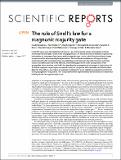The role of Snell’s law for a magnonic majority gate
Author(s)
Kanazawa, Naoki; Goto, Taichi; Sekiguchi, Koji; Granovsky, Alexander B.; Takagi, Hiroyuki; Nakamura, Yuichi; Uchida, Hironaga; Inoue, Mitsuteru; Ross, Caroline A; ... Show more Show less
DownloadRoss_The role of Snell's.pdf (4.045Mb)
PUBLISHER_CC
Publisher with Creative Commons License
Creative Commons Attribution
Terms of use
Metadata
Show full item recordAbstract
In the fifty years since the postulation of Moore's Law, the increasing energy consumption in silicon electronics has motivated research into emerging devices. An attractive research direction is processing information via the phase of spin waves within magnonic-logic circuits, which function without charge transport and the accompanying heat generation. The functional completeness of magnonic logic circuits based on the majority function was recently proved. However, the performance of such logic circuits was rather poor due to the difficulty of controlling spin waves in the input junction of the waveguides. Here, we show how Snell's law describes the propagation of spin waves in the junction of a Ψ-shaped magnonic majority gate composed of yttrium iron garnet with a partially metallized surface. Based on the analysis, we propose a magnonic counterpart of a core-cladding waveguide to control the wave propagation in the junction. This study has therefore experimentally demonstrated a fundamental building block of a magnonic logic circuit.
Date issued
2017-08Department
Massachusetts Institute of Technology. Department of Materials Science and EngineeringJournal
Scientific Reports
Publisher
Nature Publishing Group
Citation
Kanazawa, Naoki et al. “The Role of Snell’s Law for a Magnonic Majority Gate.” Scientific Reports 7, 1 (August 2017): 7898 © 2017 The Author(s)
Version: Final published version
ISSN
2045-2322